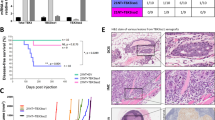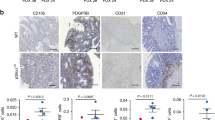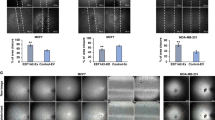Abstract
Thymidine phosphorylase (TP; also known as platelet-derived endothelial cell growth factor, PD-ECGF) is an angiogenic factor that is chemotactic for endothelial cells and has been found to induce neovascularization in vivo. TP is frequently overexpressed in human solid tumors, where its expression has been correlated with increased tumor microvessel density, invasion, and metastasis, and shorter patient survival. In this report, TP activity in the WiDr colon carcinoma cell line was found to be induced 100-fold by tumor necrosis factor (TNFα), a secretory product of activated macrophages that has indirect angiogenic activities. Increased TP activity was accompanied by increased TP mRNA levels and without an increase in mRNA stability. TNFα-induced TP mRNA levels were reduced by mithramycin, a DNA-binding transcription inhibitor specific for GC-rich sequences. Transcriptional regulation by TNFα was confirmed by transient transfection of WiDr with upstream TP sequences in a luciferase reporter construct. Deletion analysis of the reporter pinpointed two regions of the TP promoter with regulatory elements for both TNFα-inducible and basal expression, and they contained, respectively, three and one consensus binding sites for the Sp1-family of transcription factors. One additional region contributed only to basal TP expression, and it contained three Sp1 sites. TNFα-induced TP expression decreased when point mutations were made in three of the four Sp1 sites postulated to contribute to both basal and TNFα-inducible expression. Electrophoretic mobility shift assays further demonstrated binding of nuclear Sp1 to these three sites. Sp1-binding activity was also increased in cells treated with TNFα. These studies establish a role for Sp1 in the regulation of expression of the angiogenic factor TP in colon cancer WiDr cells.
This is a preview of subscription content, access via your institution
Access options
Subscribe to this journal
Receive 50 print issues and online access
$259.00 per year
only $5.18 per issue
Buy this article
- Purchase on Springer Link
- Instant access to full article PDF
Prices may be subject to local taxes which are calculated during checkout






Similar content being viewed by others
Abbreviations
- EMSA:
-
electrophoretic mobility shift assay
- PD-ECGF:
-
platelet-derived endothelial cell growth factor
- TNFα:
-
tumor necrosis factor
- TP:
-
thymidine phosphorylase
- VEGF:
-
vascular endothelial growth factor
References
Beutler B, Cerami A . 1986 Nature 320: 584–588
Blume SW, Snyder RC, Ray R, Thomas S, Koller CA, Miller DM . 1991 J. Clin. Invest. 88: 1613–1621
Bussolino F, Camussi G, Baglioni C . 1988 J. Biol. Chem. 263: 11856–11861
Cakouros D, Cockerill PN, Bert AG, Mital R, Roberts DC, Shannon MF . 2001 J. Immunol. 167: 302–310
Cao D, Nimmakayalu MA, Wang F, Zhang D, Handschumacher RE, Bray-Ward P, Pizzorno G . 1999 Cancer Res. 59: 4997–5001
Cheng N, Chen J . 2001 J. Biol. Chem. 276: 13771–13777
Eda H, Fujimoto K, Watanabe S, Ishikawa T, Ohiwa T, Tatsuno K, Tanaka Y, Ishitsuka H . 1993a Jpn. J. Cancer Res. 84: 341–347
Eda H, Fujimoto K, Watanabe S, Ura M, Hino A, Tanaka Y, Wada K, Ishitsuka H . 1993b Cancer Chemother. Pharmacol. 32: 333–338
Engels K, Fox SB, Whitehous RM, Gatter KC, Harris AL . 1997 J. Pathol. 182: 414–420
Finkenzeller G, Technau A, Marme D . 1995 Biochem. Biophys. Res. Comm. 208: 432–439
Finkenzeller G, Sparacio A, Technau A, Marme D, Siemeister G . 1997 Oncogene 15: 669–676
Finnis C, Dodsworth N, Pollitt CE, Carr G, Sleep D . 1993 Eur. J. Biochem. 212: 201–210
Folkman J, Shing Y . 1992 J. Biol. Chem. 267: 10931–10934
Frater-Schroder M, Risau W, Hallmann R, Gautschi P, Bohlen P . 1987 Proc. Natl. Acad. Sci. (USA) 84: 5277–5281
Giraudo E, Primo L, Audero E, Gerber H-P, Koolwijk P, Soker S, Klagsburn M, Ferrera N, Bussolino F . 1998 J. Biol. Chem. 273: 22128–22135
Goto H, Kohno K, Sone S, Akiyama S, Kuwano M, Ono M . 2001 Cancer Res. 61: 469–473
Greenwel P, Inagaki Y, Hu W, Walsh M, Ramirez F . 1997 J. Biol. Chem. 272: 19738–19745
Griffiths L, Dachs GU, Bicknell R, Harris AL, Stratford IJ . 1997 Cancer Res. 57: 570–572
Hagiwara K, Stenman G, Honda H, Sahlin P, Andersson A, Miyazono K, Heldin CH, Ishikawa F, Takaku F . 1991 Mol. Cell. Biol. 11: 2125–2132
Hanahan D, Folkman J . 1996 Cell 86: 353–364
Hirano F, Tanaka H, Hirano Y, Hiramoto M, Handa H, Makino I, Scheiderfeit C . 1998 Molec. Cell. Biol. 18: 1266–1274
Ishikawa F, Miyazono K, Hellman U, Drexler H, Wernstedt C, Hagiwara K, Usuki K, Takaku F, Risau W, Heldin CH . 1989 Nature 338: 557–562
Kadonga JT, Jones KA, Tjian R . 1986 Trends Biochem. Sci. 11: 20–25
Kim I, Kim JH, Ryu YS, Liu M, Koh GY . 2000 Biochem. Biophys. Res. Commun. 269: 361–365
Koukourakis MI, Giatromanolaki A, Kakolyris S, O'Byrn KJ, Apostolikas N, Skarlatos J, Gatter KC, Harris AL . 1998 Br. J. Cancer 77: 1696–1703
Krehan A, Ansuini H, Bocher O, Grein S, Wirkner U, Pyerin W . 2000 J. Biol. Chem. 275: 18327–18336
Lee AHS, Dublin EA, Bobrow LG . 1999 J. Pathol. 187: 285–290
Leibovich SJ, Polverini PJ, Shepard HM, Wiseman DM, Shively V, Nuseir N . 1987 Nature 329: 630–632
Maeda K, Chung YS, Ogawa Y, Takatsuka S, Kang SM, Ogawa M, Sawada T, Onoda N, Kato Y, Sowa M . 1996 Br. J. Cancer 73: 884–888
Miyazono K, Okabe T, Urabe A, Takaku F, Heldin CH . 1987 J. Biol. Chem. 262: 4098–4103
Naar AM, Ryu S, Tjian R . 1998 Cold Spring Harbor Symp. Quant. Biol. 63: 189–199
O'Byrne KJ, Koukourakis MI, Giatromanolaki A, Cox G, Turley H, Steward WP, Gatter K, Harris AL . 2000 Br. J. Cancer 82: 1427–1432
Okamura K, Sato Y, Matsuda T, Hamanaka R, Ono M, Kohno K, Kuwano M . 1991 J. Biol. Chem. 266: 19162–19165
Polverini PJ, Leibovich SJ . 1984 Lab. Invest. 51: 635–642
Pugh BF, Tjian R . 1991 Genes Dev. 5: 1935–1945
Rosenbaum JT, Howes Jr EL, Rubin RM, Samples JR . 1988 Am. J. Pathol. 133: 47–53
Ryuto M, Ono M, Izumi H, Yoshida S, Weich HA, Kohno K, Kuwano M . 1996 J. Biol. Chem. 271: 28220–28228
Sato N, Goto T, Haranaka K, Satomi N, Nariuchi H, Mano-Hirano Y, Sawasaki Y . 1986 J. Natl. Cancer Inst. 76: 1113–1121
Sato N, Fukuda K, Nariuchi H, Sagara N . 1987 J. Natl. Cancer Inst. 79: 1383–1389
Sawada N, Ishikawa T, Fukase Y, Nishida M, Yoshikubo T, Ishitsuka H . 1998 Clin. Cancer Res. 4: 1013–1019
Schreiber E, Matthias P, Muller MM, Schaffner W . 1989 Nucleic Acids Res. 17: 6419
Schwartz EL, Baptiste N, Wadler S, Makower D . 1995 J. Biol. Chem. 270: 19073–19077
Schwartz EL, Wan E, Wang F, Baptiste N . 1998 Cancer Res. 58: 1551–1557
Seki N, Kodama J, Hongo A, Miyagi Y, Yoshinouchi M, Kudo T . 2000 Eur. J. Cancer 36: 68–73
Shimaoka S, Matsushita S, Nitanda T, Matsuda A, Nioh T, Suenga T, Nishimata Y, Akiba S, Akiyama S, Nishimata H . 2000 Cancer 88: 2220–2227
Smale ST . 1997 Biochim. Biophys. Acta 1351: 73–88
Sumizawa T, Furukawa T, Haraguchi M, Yoshimura A, Takeyasu A, Ishizawa M, Yamada Y, Akiyama S . 1993 J. Biochem. (Tokyo) 114: 9–14
Suske G . 1999 Gene 238: 291–300
Takahashi Y, Bucana CD, Liu W, Yoneda J, Kitadai Y, Cleary KR, Ellis LM . 1996 J. Natl. Cancer Inst. 88: 1146–1151
Takahashi Y, Bucana CD, Akagi Y, Liu W, Cleary KR, Mai M, Ellis LM . 1998 Clin. Cancer Res. 4: 429–434
Takebayashi Y, Akiyama S, Akiba S, Yamada K, Miyadera K, Sumizawa T, Yamada Y, Murata F, Aikou T . 1995 Cancer Lett. 95: 57–62
Takebayashi Y, Akiyama S, Akiba S, Yamada K, Miyadera K, Sumizawa T, Yamada Y, Murata F, Aikou T . 1996 J. Natl. Cancer Inst. 88: 1110–1117
Tevaearai HT, Laurent PL, Suardet L, Eliason JF, Givel JC, Odartchenko N . 1992 Eur. J. Cancer 28: 368–372
van Triest B, Pinedo HM, Blauuwgeers JLG, van Diest PJ, Schoenmakers PS, Voorn DA, Smid K, Hoekman K, Hoitsma HFW, Peters GJ . 2000 Clin. Cancer Res. 6: 1063–1072
Watanabe S, Uchida T . 1995 Biochem. Biophys. Res. Comm. 216: 265–272
Watanabe S, Hino A, Wada K, Eliason JF, Uchida T . 1995 J. Biol. Chem. 270: 12191–12196
Zhang D, Cao D, Russell R, Pizzorno G . 2001 Cancer Res. 61: 6899–6905
Zimmerman M, Seidenberg J . 1964 J. Biol. Chem. 239: 2618–2621
Acknowledgements
This study was supported by grants R01-CA54422, R01-CA89352, and P01-CA13330 from the National Cancer Institute.
Author information
Authors and Affiliations
Corresponding author
Rights and permissions
About this article
Cite this article
Zhu, G., Lenzi, M. & Schwartz, E. The Sp1 transcription factor contributes to the tumor necrosis factor-induced expression of the angiogenic factor thymidine phosphorylase in human colon carcinoma cells. Oncogene 21, 8477–8485 (2002). https://doi.org/10.1038/sj.onc.1206030
Received:
Revised:
Accepted:
Published:
Issue Date:
DOI: https://doi.org/10.1038/sj.onc.1206030
Keywords
This article is cited by
-
Lidamycin up-regulates the expression of thymidine phosphorylase and enhances the effects of capecitabine on the growth and pulmonary metastases of murine breast carcinoma
Cancer Chemotherapy and Pharmacology (2013)
-
A novel role for TNFAIP2: its correlation with invasion and metastasis in nasopharyngeal carcinoma
Modern Pathology (2011)
-
Thymidine phosphorylase mRNA stability and protein levels are increased through ERK-mediated cytoplasmic accumulation of hnRNP K in nasopharyngeal carcinoma cells
Oncogene (2009)
-
Divergent mechanisms underlie Smad4-mediated positive regulation of the three genes encoding the basement membrane component laminin-332 (laminin-5)
BMC Cancer (2008)
-
Suppression of thymidine phosphorylase expression by promoter methylation in human cancer cells lacking enzyme activity
Cancer Chemotherapy and Pharmacology (2008)



